Staff Spotlight: Kate Byrnes
As we head into the colder months with shorter days and look forward to holidays full of treats, toys, and togetherness, we wanted to highlight a very special staff member who keeps the DLC lemurs entertained all year round. Kate Byrnes, enrichment-maker extraordinaire, tells us all about her job as the Duke Lemur Center’s first enrichment technician.
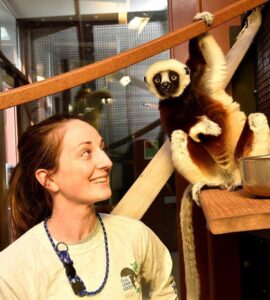
DLC Enrichment Technician Kaye Byrnes with Coquerel’s Sifaka Remus
Q: What does your current position at the DLC entail? What is a “day in the life” for you?
A: My current position at the Duke Lemur Center is enrichment technician three days a week and husbandry technician 2 days a week. In the enrichment technician position, I assist with managing and implementing the enrichment program for all of the animals at the DLC as well as stocking, maintaining, and building the items used for enrichment.
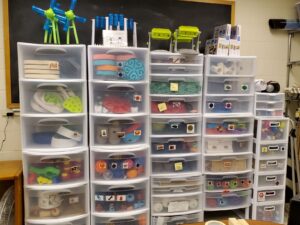
The DLC has a wide variety of enrichment supplies, some of which have been donated by our wonderful supporters. More information on how to send our lemurs a present via our Amazon wishlist can be found here.
Q: In your words, what is enrichment, and why is it important?
A: Enrichment is an opportunity to encourage natural behaviors in an animal under our care. Basic care for an animal could be providing a place to sleep, water to drink, and food to eat, but of course we never want to just stop at the basics. Here at the DLC and accredited zoos all over the world, we want to find ways to enhance the welfare of the animals within our care. Enrichment is one of the most important ways to do that. It is not just about giving an animal a toy, but stimulating them both mentally and physically, and giving them options to behave in ways that are natural and observed in the wild. Enrichment can be environmental, sensory, diet –based and so much more!
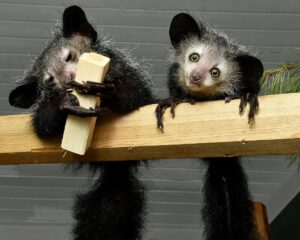
Aye-Aye mom Ardrey enjoys a wooden worm feeder while daughter Melisandre looks on.
Q: What are some of the coolest/most interesting/most well-received enrichment ideas you’ve had?
A: Structural enrichment is probably my favorite type of enrichment to focus on because it allows you to create new ways for any animal to interact with an environment that they may have occupied for years. When I evaluate a lemur enclosure, I try to find those empty “spaces” that an animal can’t currently use and build some type of structure or shelf that essentially creates a new space for them. At the DLC, my cedar shelves have probably been the most successful in achieving this goal. They provide a new feed spot, a sunning spot, and a new item to scent mark. I have even started creating tiny ones for our small nocturnal lemurs that allows us to increase the amount of scatter feeding options within their enclosure, instead of simply giving them their food in bowls every day.
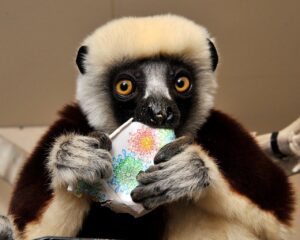
A Coquerel’s Sifaka enjoys a cup with peanut butter smeared inside.
Q: How did you come to be in this position? What did you study in school, and where have you worked previously?
A: I was introduced to enrichment while volunteering at a museum in Dayton, Ohio. One of my tasks was to sit in the keeper office, in the dark, and find ways to encourage an overweight hedgehog to “exercise”. This required me to spend time researching the natural history of hedgehogs to know they are nocturnal (hence why I was sitting in the dark), but also how they forage for their food, so I began taking her diet and just hiding it all around the office. So, sitting on the floor in the office with minimal light, I got to spend at least a half hour every shift just watching a hedgehog run around, and my love for enrichment was born.
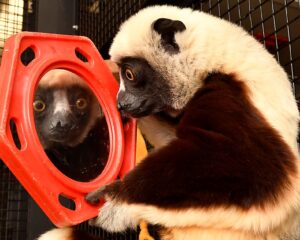
Lemurs do not recognize their reflections, so mirrors can be engaging enrichment.
Later, I worked at a larger zoo, The Living Desert in Palm Springs, CA. My first year as keeper at this facility focused mostly on hoofstock, like giraffe, zebra, and kudu. These animals are particularly difficult to enrich because as prey species, they are terrified of everything. It was a challenge at first, but a good one since it forced me to think outside of the box on what is defined as an enriching experience. I definitely learned the difference between positive and negative enrichment, and the consequences of putting in new enrichment in an animal’s night house and them not wanting to shift in for the evening because they are now terrified of that new enrichment.
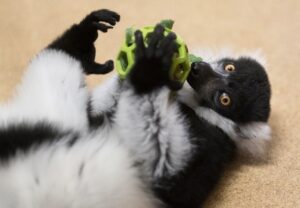
A black and white ruffed lemur engages with an enrichment ball filled with its favorite snacks.
After a few years at that zoo, I was ready to find a facility that I wanted to stay with for a long period of time with a strong focus on research and conservation. And so, a little over six years ago I was hired here! I then discovered that lemurs are some of the most fascinating animals to enrich because of their diverse variety of behaviors and their natural sense of curiosity. After a few years here, I was able to develop a special focus in enrichment. While in this role, I began to realize all of the work I would love to do to enhance our enrichment program at the center for both animal welfare and visitor experience. I proposed the idea of a split role so I could have more time to develop these ideas and work closely with our curator of behavioral management, and here I am today!

